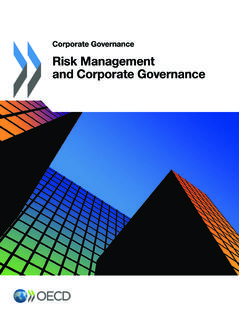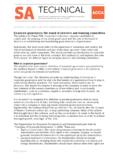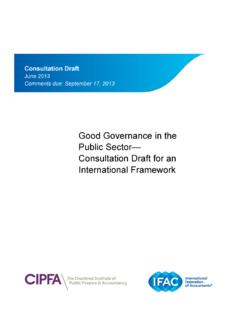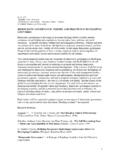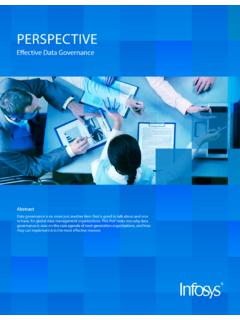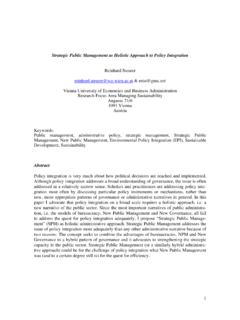Transcription of Information governance for the real world - EY
1 1 Information governance for the real world 2 Information governance is a business issue. Organizations should have an effective Information governance strategy that aligns with their overall risk management strategy, and that can be effectively operationalized to leverage and protect Information assets and accomplish broader business Information risks span Information disciplinesRecent headlines describing cyber attacks and leaked private communications make most organizations worry, Can this happen to us? Yet, Information security breaches are just one of many Information risks that companies are struggling to come to grips with. Faced with this latest threat, will companies respond by throwing resources only at this latest challenge, or will they respond with a broader strategy that links Information risks across the enterprise? Companies should ask themselves if it s time to abandon the rigid division of Information risks into Information disciplines Information security, privacy, records and Information management, eDiscovery and so forth and instead enable these disciplines to work together to address risks that, in the real world , span across them.
2 Some organizations have already recognized the need to draw together Information management disciplines to better manage risks that cut across traditional organizational boundaries. Improved governance has commonly come in the form of increased cooperation between records management, legal, compliance, privacy and Information technology (IT) and is spurred by, and generally related to, the mitigation of discovery risks. This is admirable, but it does not go far enough. Information disciplines responsible for structured data, data security, Information access management, master data management and functions typically in IT continue to be isolated from what is, in any event, an informal arrangement between functions. Each function tackles its own Information risks in its own way, often missing opportunities to leverage relevant expertise, previously completed work, and the resources and technology available in other Information risk functions. Without the benefit of a broader understanding of the complex dependencies between risks and planned or in-flight Information risk management initiatives, individual risk functions may not realize all of the available opportunities to manage Information risk.
3 1 Information governance is the activities and technologies that organizations employ to maximize the value of their Information while minimizing associated risks and costs. The Information governance Initiative, The Information governance Initiative, , accessed January 30, key considerations of a robust Information governance program The need for a strong Information governance program is driven by the goals of the individual Information disciplines, such as compliance with laws and regulations, protection of data, enhanced response to eDiscovery demands and achieving business imperatives. An Information governance program is the glue between functions enabling enterprise Information risk management and improved coordination and cooperation between disciplines without requiring changes to the reporting structures. An Information governance program, by improving risk management and coordination across Information disciplines, helps companies better manage challenges, such as the following: Responding to regulatory requirements.
4 Rigorous compliance requirements may include international standards, such as those contained in Basel III; European Union laws such as the Markets in Financial Instruments Directive; and US regulations issued by agencies such as the Financial Industry Regulatory Authority, Securities and Exchange Commission and the Food and Drug Administration. There are also a wide range of safety-related record requirements that may impact chemical, utility, oil and gas, automotive and other manufacturing companies. Among other objectives, these regulations look to protect consumers and maintain privacy rights by outlining what Information organizations need to retain, how to retain the Information (addressing both access and security) and what Information can be transported across borders. The discovery process. Traditionally, outside counsel and third-party vendors have held a firm grip on the operations components of the discovery process. Additionally, the preservation and collection of electronic Information was generally supported by corporate IT groups, which may have used a black box approach to preservation and collection of data.
5 In recent years, judges are penalizing organizations for not taking more responsibility for their discovery process. Because of this, discovery support is shifting to its own distinct, in-house program that is in need of improved policies, procedures and controls. Proliferation of systems. Information is collected, processed and exchanged between many different internal systems, as well as external organizations (including government agencies), making understanding data flows and monitoring regulatory compliance increasingly difficult. Many organizations adopt BYOD policies and issue tablets and other portable devices, further compounding these challenges. An increasing volume of Information . As the volume of Information increases, so does the number of Information systems 3and servers. As volume increases and new Information systems are procured, Information may shift around the country or globe. As this happens, organizations tend to lose their understanding and control of what Information is stored where.
6 This presents risks when an organization must apply records retention policies, respond to discovery or regulatory requests, determine compliance with privacy requirements, etc. If companies cannot identify data and dispose of it in accordance with retention policies, then that data may be discoverable and increase eDiscovery risks and costs. Increased risk of cyber attacks. Publicized cyber events amplify the risks to all organizations trying to protect their critical Information . The resulting loss of trust and reputational damage has led to economic and revenue hits for both small and multinational organizations. Without knowledge of an organization s critical assets, too many resources are spent on protecting everything. While there are many ways to gain access to an organization s environment, whether through third-party vendors with too much access or social engineering of the front line, the goal is to build up defenses around those critical assets. Outsourcing.
7 Outsourcing IT services, including to offshore locations, increases both security and compliance risks. Third-party service and infrastructure providers outside of the organization that have custody of the organization s Information may not have appropriate protections or Information governance capabilities in place. 1 How can your Information governance be improved? Does your organization have an Information governance strategy? Are Information governance objectives defined and communicated, and are resources allocated? Are Information governance policies and procedures well defined and socialized throughout the organization? Does your company effectively meet legal and regulatory requirements? Are Information governance risks considered when business decisions are made? For example, when an organization rolls out a bring-your-own-device (BYOD) technology model, are risks related to eDiscovery, records management, Information security, etc., considered holistically?
8 4 Information governance is not a project or an Information management discipline it enables Information management disciplines to be managed holistically. Through its Information governance program, the organization can better understand and address enterprise Information risks. The emphasis in Information governance is squarely on governance . The Information governance program does not replace existing Information disciplines or reporting structures for those disciplines, but establishes shared governance and a culture of coordination and integration between governanceInformation access managementPrivacyData protectionMaster data managementDiscovery and legal holdsRecords and Information managementTrue Information governance is a program 5 How we can helpErnst & Young LLP works with organizations to find opportunities to mitigate overlapping risks by bringing these siloed functions together. When organizations implement a well-balanced Information governance program, they can better identify effective approaches to managing and mitigating enterprise Information risks.
9 Information governance program assessment and strategy development diagnostic. Ernst & Young LLP employs a diagnostic that is based on the four foundational components of our Information governance framework: strategy, governance , operations and performance measurement (see graphic on page 6). By observing and evaluating the organization s current approach to Information risk across disciplines, the organization begins to understand the current state of its Information governance program and can plan for its desired future state. The diagnostic identifies risks across the spectrum that can be aligned to recommendations for improvement. Information governance program maturity model. The Information governance diagnostic described above can also be used to develop a profile of the organization s Information governance program and its maturity compared with other organizations in the same industry. The maturity model may also reflect the organization s desired future state and depict the gaps that must be closed to achieve the future state.
10 Information governance program development. We work closely with organizations to help them realize their future-state Information governance programs. This work can involve establishing a committee that includes executives from the various Information management disciplines and other stakeholders; working with stakeholders to develop or streamline corporate strategy, policies, procedures, standards, reporting and controls to support the revised program and its initiatives; 6 The four components of our shared-focus framework provide an effective design and solid foundation for implementing a sustainable Information governance : This describes how Information governance will help realize the business strategy, facilitate compliance with applicable regulations, improve operations, manage risk and improve the organization s economic position. governance : This includes defining the Information governance organization and the ongoing maintenance, administration and safekeeping of the Information governance : This comprises the infrastructure, systems and processes that make the Information governance program measurement: This consists of assessing how well Information governance is performing against the needs of the business and expectations of the measurementGovernanceOperations 7developing change management plans to prepare employees for changes to the Information governance program; helping implement training programs to socialize the new model and policies; and more.










